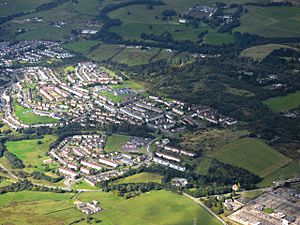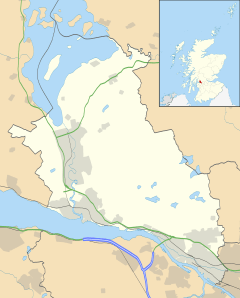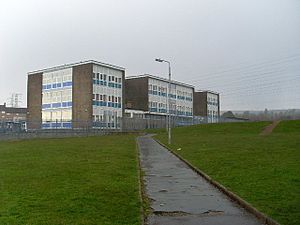Faifley facts for kids
Quick facts for kids Faifley
|
|
|---|---|
 Faifley from the air (2017) |
|
| Population | 4,740 (2020) |
| OS grid reference | NS505567 |
| Council area | |
| Lieutenancy area | |
| Country | Scotland |
| Sovereign state | United Kingdom |
| Post town | CLYDEBANK |
| Postcode district | G81 5 |
| Dialling code | 0141/01389 |
| Police | Strathclyde |
| Fire | Strathclyde |
| Ambulance | Scottish |
| EU Parliament | Scotland |
| UK Parliament | |
| Scottish Parliament |
|
Faifley (which in Scottish Gaelic is Fionn Bhealach) is a large housing area. It is part of the town of Clydebank in Scotland. Faifley is right next to the old village of Hardgate.
About 5,000 people live in Faifley. When you add Faifley to Duntocher and Hardgate, the total population was about 12,719 in 2011. These areas are all part of the Kilpatrick ward in West Dunbartonshire.
Over the years, Faifley has changed a lot. Many older homes have been removed, rebuilt, or updated. Faifley has two schools, each with a church nearby. Edinbarnet Primary is a non-religious school, linked with the White Church. St Joseph's Primary is a Roman Catholic school, linked with St Joseph's Church.
The community used to have a large store called "Boabs". The community centre also had the Faifley Branch Library. This library closed in March 2011 but reopened on December 6, 2013. Today, the Faifley Library is located behind Edinbarnet Campus, on Craigpark Street.
Contents
Faifley's Story: A Look Back in Time
What's in a Name? Faifley's Early History
The area we now call Faifley has a very old name. In 1227, when land was given to the Monks of Paisley Abbey, it was called Fimbalach. This name might have meant "The White Pass." Later, in 1587, it was called Ferchlay, and by 1594, Fachla.
The name "Faifley" first referred to the land around Cochno Road. This area is north of Hardgate, between two streams: the West Burn and the East Burn. These two streams join together at the Hardgate Mill to form the Duntocher Burn.
We know people lived here a very long time ago. In 1887, a stone called the Cochno Stone was found at Auchnacraig. This large sandstone rock, about 18 meters wide, has special "cup and ring" carvings. These are ancient symbols carved into rocks. You can still see smaller rocks with these marks in the area. Another ancient site is the Cairnhowat burial cairn, which is a very old burial mound.
Important Families and Estates
The most valuable lands near Faifley were the estates of Cochno, Edinbarnet, and Law. Before the Reformation, these lands belonged to Paisley Abbey. They were later given to the Hamilton family. Andrew Hamilton, who was in charge of Dumbarton Castle, got Cochno in 1550. However, he lost it after supporting Mary, Queen of Scots in a battle in 1568. By 1592, the Crown gave the estates back to Claud Hamilton of Cochno.
The current Cochno house was built in 1757, with more parts added in 1842. The Hamilton family owned Cochno until 1900. Today, the estate and farm are managed by the University of Glasgow Veterinary School.
The Edinbarnet and Law estates were bought by Andrew Stirling in 1569. The Stirling family owned Edinbarnet for many years. Later, the estate was sold to Walter Mackenzie. He built a new mansion in 1882, replacing an older house from 1644. This new house was damaged by fire but was rebuilt. In 1988, the house was turned into a nursing home.
Places of Worship: Faifley's Churches
In 1777, some people left the Old Kilpatrick Parish Church. They formed a new group and built a church in 1781 at Kilpatrick Craigs. This group later split into two smaller groups in 1799. However, they came back together after 1860. They formed the Craigs and Duntocher United Free Church. They worshipped at a church built in 1822 in Duntocher.
In 1956, the Church of Scotland closed the Duntocher East Church in Hardgate. They built a new church, known as "The White Church," on Faifley Road.
Working Life: Faifley's Industries
Faifley's first industries used the power of water from the Loch Humphrey Burn and the Cochno Burn. There was a mill for processing cloth and a dye works. In 1811, William Dunn bought the Faifley Cotton Spinning Co. He had four large cotton mills that used the water power. By 1836, he also used the first steam engines in Faifley. At that time, he employed 1,400 workers.
However, the American Civil War in the 1860s caused problems for Britain's cotton trade. This led to most of the mills closing down. Only one mill remained open.
The Faifley Mill was later turned into a furniture factory. It was owned by Solomon Levy Abrahams. This factory was known as the "Jew's Mill." The building on Cochno Road was even called Abrahams' Land. After World War II, a company called Dairyority used the building to make and fix dairy equipment. The last owners were MacKechnie's Rolls, a bakery. The bakery closed in 1991, and the old mill buildings were taken down to build new homes.
Other small businesses also existed in Faifley. James Marr's Faifley Spade Forge made spades until the 1880s. This might have been part of the Dalnotter Iron Works, which started a century earlier. You can still see the old mill channel behind Hillcrest Avenue. There was also a pottery and another forge that used the Cochno Burn.
Building Homes: Faifley's Housing
In 1949, Clydebank Town Council was allowed to take over the Faifley area. In 1953, they started building new homes at Auchinleck Farm. The Jamieson family moved their dairy cows, and their farmhouse became part of the Doublet public house in 1963. The Council also built houses closer to Hardgate. The Scottish Special Housing Association built many flats and terraced houses on the higher ground. Many four-story buildings were made using new methods with poured concrete.
Eventually, the housing area grew to have over 9,000 people. When Faifley Primary School was built, it was very crowded, with three students for every seat.
Edinbarnet Junior Secondary and Primary schools were built north of the new housing. St Joseph's Primary, a Roman Catholic school, was built on Faifley Road. The Church of Scotland built a new church, "The White Church," on Faifley Road in 1956. A Community/Leisure centre was built in 1970 with help from a German organization. This was a friendly gesture after the Clydebank Blitz.
Faifley in Modern Times
In 1958, a group from the Faifley Tenants' Association went to Edinburgh. They complained about the poor housing conditions and the different rents for Council and SSHA houses. The area also had few services, was far away from other places, and had high unemployment. A special group was set up to help solve some of these problems.
Many of the homes had problems because of how they were built. There have been many projects to repair and rebuild them. Many SSHA houses have been replaced with newer, less crowded housing. This has reduced the population to about 4,000 people. Because fewer people live there, Faifley Primary School closed. In 2004, it became a Library and Community Centre.





